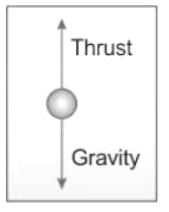EmSAT Achieve Exam > EmSAT Achieve Questions > An object is put one by one in three liquids ...
Start Learning for Free
An object is put one by one in three liquids P, Q, and R having different densities. Consider the following statements and arrange the liquids in ascending order of densities.
(A) In liquid P, the object is completely submerged
(B) In liquid Q, objects float with (1/4)th part of their volume inside the liquid
(C) In liquid R, objects float with (1/2)th of their volume inside the liquid
- a)R < Q < P
- b)P < Q < R
- c)Q < R < P
- d)P < R < Q
Correct answer is option 'D'. Can you explain this answer?
Verified Answer
An object is put one by one in three liquids P, Q, and R having differ...
Concept:
Archimedes principle:
Principle of Archimedes states “When a body is immersed in a liquid, an upward thrust, equal to the weight of the liquid displaced, acts on it.”

- Thus, when a solid is fully immersed in a liquid, it loses weight which is equal to the weight of the liquid it displaces.
Apparent weight = Actual weight - buoyant force = mg - ρgV
Where m is the mass of the object, ρ is the density of the fluid
- Hence if there is no gravity, there is no Upward Thrust.
- The upward force applied to the object is called the buoyant force.
Here,
ρ = density of liquid
g = acceleration due to gravity
V = volume of liquid displaced by the object
Explanation:
- When a body is immersed partially or completely in a fluid (liquid or gas), it experiences an upthrust or buoyant force that is equal to the weight of the fluid displaced by the body.
- So the upthrust on the ball is given as,
⇒ FB = ρVg
⇒ FB ∝ ρ -----(1)
Where ρ = density of the liquid, V = volume of liquid displaced = volume of ball, and g = gravitational acceleration
- Buoyant Force is when a rigid object is submerged in a fluid (completely or partially), and there exits an upward force on the object that is equal to the weight of the fluid that is displaced by the object.
- In liquid P, the object is completely submerged- The volume of the fluid displaced is equal to the volume of the object.
- In liquid Q, objects float with (1/4)th part of their volume inside the liquid- Here, (1/4) th means 0.25.
- In liquid R, objects float with (1/2)th of their volume inside the liquid - Here, (1/2) means 0.50
- As density is inversely proportional to volume, liquid Q has less volume so density will be high as compared to R and P.
So, it is proven that P < R < Q.
Additional Information
- Archimedes Principle is also known as the physical law of buoyancy.
- The purity of gold in the king's crown, Archimedes determines after discovering the Archimedes principle.
- Hydrometers, Ships, and Submarines work on the Archimedes Principle.
- A Ship/boat floats on the basis of the Archimedes Principle.
Most Upvoted Answer
An object is put one by one in three liquids P, Q, and R having differ...
Understanding Liquid Densities
To determine the order of densities of liquids P, Q, and R based on the behavior of objects placed in them, we analyze each statement provided.
Analysis of Liquids
- Liquid P:
- The object is completely submerged.
- This indicates that the density of liquid P is greater than the density of the object.
- Liquid Q:
- Objects float with (1/4)th of their volume submerged.
- According to Archimedes' principle, this means that the density of liquid Q is less than the density of the object but greater than (1/4)th of the object’s density.
- Liquid R:
- Objects float with (1/2)th of their volume submerged.
- This indicates that the density of liquid R is less than the density of the object but greater than (1/2)th of the object’s density.
Comparative Densities
From the above analyses, we can summarize:
- Density Relationships:
- Density of R < density="" of="" q="" />< density="" of="" />
Conclusion
Thus, we can arrange the liquids in ascending order of densities as follows:
- Ascending Order of Densities:
- R < q="" />< />
Therefore, the correct answer is option 'D': P < r="" />< q.="" this="" arrangement="" reflects="" that="" liquid="" r="" is="" the="" least="" dense,="" followed="" by="" liquid="" q,="" and="" finally="" liquid="" p="" has="" the="" highest="" density.="" q.="" this="" arrangement="" reflects="" that="" liquid="" r="" is="" the="" least="" dense,="" followed="" by="" liquid="" q,="" and="" finally="" liquid="" p="" has="" the="" highest="" />
To determine the order of densities of liquids P, Q, and R based on the behavior of objects placed in them, we analyze each statement provided.
Analysis of Liquids
- Liquid P:
- The object is completely submerged.
- This indicates that the density of liquid P is greater than the density of the object.
- Liquid Q:
- Objects float with (1/4)th of their volume submerged.
- According to Archimedes' principle, this means that the density of liquid Q is less than the density of the object but greater than (1/4)th of the object’s density.
- Liquid R:
- Objects float with (1/2)th of their volume submerged.
- This indicates that the density of liquid R is less than the density of the object but greater than (1/2)th of the object’s density.
Comparative Densities
From the above analyses, we can summarize:
- Density Relationships:
- Density of R < density="" of="" q="" />< density="" of="" />
Conclusion
Thus, we can arrange the liquids in ascending order of densities as follows:
- Ascending Order of Densities:
- R < q="" />< />
Therefore, the correct answer is option 'D': P < r="" />< q.="" this="" arrangement="" reflects="" that="" liquid="" r="" is="" the="" least="" dense,="" followed="" by="" liquid="" q,="" and="" finally="" liquid="" p="" has="" the="" highest="" density.="" q.="" this="" arrangement="" reflects="" that="" liquid="" r="" is="" the="" least="" dense,="" followed="" by="" liquid="" q,="" and="" finally="" liquid="" p="" has="" the="" highest="" />

|
Explore Courses for EmSAT Achieve exam
|

|
Question Description
An object is put one by one in three liquids P, Q, and R having different densities. Consider the following statements and arrange the liquids in ascending order of densities.(A) In liquid P, the object is completely submerged(B) In liquid Q, objects float with (1/4)thpart of their volume inside the liquid(C) In liquid R, objects float with (1/2)thof their volume inside the liquida)R < Q < Pb)P < Q < Rc)Q < R < Pd)P < R < QCorrect answer is option 'D'. Can you explain this answer? for EmSAT Achieve 2025 is part of EmSAT Achieve preparation. The Question and answers have been prepared according to the EmSAT Achieve exam syllabus. Information about An object is put one by one in three liquids P, Q, and R having different densities. Consider the following statements and arrange the liquids in ascending order of densities.(A) In liquid P, the object is completely submerged(B) In liquid Q, objects float with (1/4)thpart of their volume inside the liquid(C) In liquid R, objects float with (1/2)thof their volume inside the liquida)R < Q < Pb)P < Q < Rc)Q < R < Pd)P < R < QCorrect answer is option 'D'. Can you explain this answer? covers all topics & solutions for EmSAT Achieve 2025 Exam. Find important definitions, questions, meanings, examples, exercises and tests below for An object is put one by one in three liquids P, Q, and R having different densities. Consider the following statements and arrange the liquids in ascending order of densities.(A) In liquid P, the object is completely submerged(B) In liquid Q, objects float with (1/4)thpart of their volume inside the liquid(C) In liquid R, objects float with (1/2)thof their volume inside the liquida)R < Q < Pb)P < Q < Rc)Q < R < Pd)P < R < QCorrect answer is option 'D'. Can you explain this answer?.
An object is put one by one in three liquids P, Q, and R having different densities. Consider the following statements and arrange the liquids in ascending order of densities.(A) In liquid P, the object is completely submerged(B) In liquid Q, objects float with (1/4)thpart of their volume inside the liquid(C) In liquid R, objects float with (1/2)thof their volume inside the liquida)R < Q < Pb)P < Q < Rc)Q < R < Pd)P < R < QCorrect answer is option 'D'. Can you explain this answer? for EmSAT Achieve 2025 is part of EmSAT Achieve preparation. The Question and answers have been prepared according to the EmSAT Achieve exam syllabus. Information about An object is put one by one in three liquids P, Q, and R having different densities. Consider the following statements and arrange the liquids in ascending order of densities.(A) In liquid P, the object is completely submerged(B) In liquid Q, objects float with (1/4)thpart of their volume inside the liquid(C) In liquid R, objects float with (1/2)thof their volume inside the liquida)R < Q < Pb)P < Q < Rc)Q < R < Pd)P < R < QCorrect answer is option 'D'. Can you explain this answer? covers all topics & solutions for EmSAT Achieve 2025 Exam. Find important definitions, questions, meanings, examples, exercises and tests below for An object is put one by one in three liquids P, Q, and R having different densities. Consider the following statements and arrange the liquids in ascending order of densities.(A) In liquid P, the object is completely submerged(B) In liquid Q, objects float with (1/4)thpart of their volume inside the liquid(C) In liquid R, objects float with (1/2)thof their volume inside the liquida)R < Q < Pb)P < Q < Rc)Q < R < Pd)P < R < QCorrect answer is option 'D'. Can you explain this answer?.
Solutions for An object is put one by one in three liquids P, Q, and R having different densities. Consider the following statements and arrange the liquids in ascending order of densities.(A) In liquid P, the object is completely submerged(B) In liquid Q, objects float with (1/4)thpart of their volume inside the liquid(C) In liquid R, objects float with (1/2)thof their volume inside the liquida)R < Q < Pb)P < Q < Rc)Q < R < Pd)P < R < QCorrect answer is option 'D'. Can you explain this answer? in English & in Hindi are available as part of our courses for EmSAT Achieve.
Download more important topics, notes, lectures and mock test series for EmSAT Achieve Exam by signing up for free.
Here you can find the meaning of An object is put one by one in three liquids P, Q, and R having different densities. Consider the following statements and arrange the liquids in ascending order of densities.(A) In liquid P, the object is completely submerged(B) In liquid Q, objects float with (1/4)thpart of their volume inside the liquid(C) In liquid R, objects float with (1/2)thof their volume inside the liquida)R < Q < Pb)P < Q < Rc)Q < R < Pd)P < R < QCorrect answer is option 'D'. Can you explain this answer? defined & explained in the simplest way possible. Besides giving the explanation of
An object is put one by one in three liquids P, Q, and R having different densities. Consider the following statements and arrange the liquids in ascending order of densities.(A) In liquid P, the object is completely submerged(B) In liquid Q, objects float with (1/4)thpart of their volume inside the liquid(C) In liquid R, objects float with (1/2)thof their volume inside the liquida)R < Q < Pb)P < Q < Rc)Q < R < Pd)P < R < QCorrect answer is option 'D'. Can you explain this answer?, a detailed solution for An object is put one by one in three liquids P, Q, and R having different densities. Consider the following statements and arrange the liquids in ascending order of densities.(A) In liquid P, the object is completely submerged(B) In liquid Q, objects float with (1/4)thpart of their volume inside the liquid(C) In liquid R, objects float with (1/2)thof their volume inside the liquida)R < Q < Pb)P < Q < Rc)Q < R < Pd)P < R < QCorrect answer is option 'D'. Can you explain this answer? has been provided alongside types of An object is put one by one in three liquids P, Q, and R having different densities. Consider the following statements and arrange the liquids in ascending order of densities.(A) In liquid P, the object is completely submerged(B) In liquid Q, objects float with (1/4)thpart of their volume inside the liquid(C) In liquid R, objects float with (1/2)thof their volume inside the liquida)R < Q < Pb)P < Q < Rc)Q < R < Pd)P < R < QCorrect answer is option 'D'. Can you explain this answer? theory, EduRev gives you an
ample number of questions to practice An object is put one by one in three liquids P, Q, and R having different densities. Consider the following statements and arrange the liquids in ascending order of densities.(A) In liquid P, the object is completely submerged(B) In liquid Q, objects float with (1/4)thpart of their volume inside the liquid(C) In liquid R, objects float with (1/2)thof their volume inside the liquida)R < Q < Pb)P < Q < Rc)Q < R < Pd)P < R < QCorrect answer is option 'D'. Can you explain this answer? tests, examples and also practice EmSAT Achieve tests.

|
Explore Courses for EmSAT Achieve exam
|

|
Signup for Free!
Signup to see your scores go up within 7 days! Learn & Practice with 1000+ FREE Notes, Videos & Tests.


















